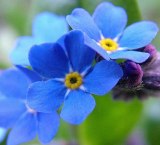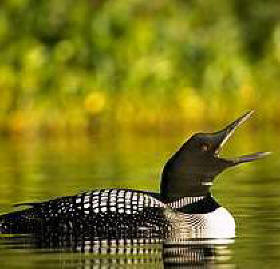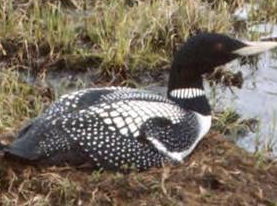Loons are known as “spirits of the wilderness,” and it is fitting that Alaska has all five species of loons found in the world. Loons are an integral part of Alaska's wilderness, a living symbol of Alaska's clean water and high level of environmental quality. Loons, especially common loons, are most famous for their call. The cry of a loon piercing the summer twilight is one of the most thrilling sounds of nature. The sight or sound of one of these birds in Alaskan waters gives a special meaning to many, as if it were certifying the surrounding as a truly wild place. The five species of loons found in Alaska are the common, yellow-billed, red-throated, pacific and arctic
Loons have stout bodies, long necks, pointed bills, three-toed webbed feet, and spend most of their time afloat. Loons are sometimes confused with cormorants, mergansers, grebes, and other diving water birds. Loons have solid bones, and compress the air out of their feathers to float low in the water. A loon's bill is held parallel to the water, but the cormorant holds its hooked bill at an angle. Mergansers have narrower bills and a crest. Grebes, also diving water birds, are relatively short-bodied. Loons can be distinguished from ducks in flight by their slower wing beat and low-slung necks and heads.
Adult loons leave younger birds at the coast and arrive at their freshwater nesting grounds by late May. Loon pairs mate for life and return every year to the same area to breed. The nests are typically right at the shoreline on islands or points of land. They are made of debris or rotting vegetation formed into a simple mound. Two drab-colored eggs are laid in late May or June. The parents take turns incubating them for about a month. The young are precocious and leave the nest within a day or two, then ride on their parents' backs more than half the time in their first week of life.
Common loons have deep black or dark green heads and necks and dark backs with an intricate pattern of black and white stripes, spots, squares, and rectangles. Both males and females are marked the same. In winter, all loons fade to dark brown on top with white undersides, but the species can be distinguished by markings and bill shape and color. Common loons spend the summer on lakes all over the state, except in very northern and western Alaska tundra where the yellow-billed nests. Commons winter along the southern coast from the Aleutian Islands south to Baja California.
The yellow-billed loon is similar in looks to the common loon, but it has white spots on its back and a straw-yellow bill even in winter. The yellow-billed is the largest of the loons, coming in at 30-36 inches long. it is also one of the largest diving birds in North America. Yellow-billeds winter along the southcoastal and southeastern waters. Occasionally, you can see them off Homer Spit or around the Cordova boat harbor, and some congregate in the northern portion of Southeast Alaska.
Red-throated loons, Pacific loons, and arctic loons are smaller varieties, a little over two feet long, and readily distinguished from their larger cousins by gray rather than black heads. As its name implies, the red-throat has a triangular throat patch of vivid, rusty red. It has a thin, slightly upturned bill and vertical white stripes on the back of its head and neck. Its back is thickly speckled with white. The red-throated loon breeds in coastal ponds and marshes around the state and spends the winter along the Pacific coast from the Aleutian Islands to Baja.
Pacific loons until recently were considered a subspecies of Arctic loon. The throat of the Pacific loon is purplish black while its black back has bars and spots of white, similar to the common and yellow-billed. Arctic loons have a greenish-black throat, but otherwise look similar to Pacific loons. Pacific loons have a wide summer distribution around the state and are the most common wintering loon on southcentral and southeastern coasts.
During fall migration, some loons congregate on large inland lakes before flying to coastal wintering areas. The young mature in two years, spending their second summer on the coast, rather than the freshwater lakes and ponds preferred by mature nesting pairs.
Loons are perhaps the best diving birds. They can stay underwater more than a minute and have been found caught in fish nets 240 feet (73 m) deep. They propel themselves underwater with their feet, using their wings for turning. Loons feed on small fish but are also known to eat aquatic vegetation, insects, mollusks, and frogs. When alarmed, loons prefer diving for safety to flying. The larger loons need long take-off runs (up to one-quarter mile (400 m)) to get airborne, but once aloft they are strong flyers, clocked as fast as 60 mph. They slide on their breasts instead of their feet when they land. They do not walk well on land, because their feet are set so far back on their bodies.
|
|








